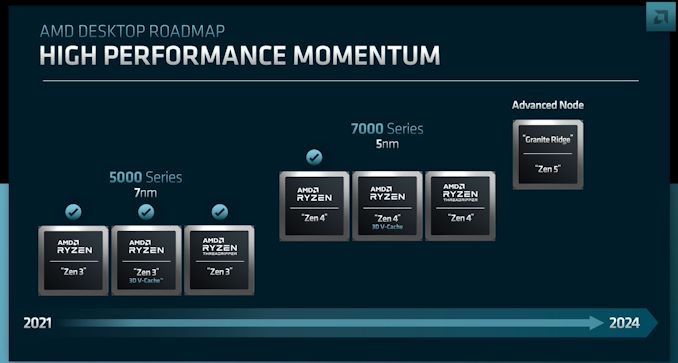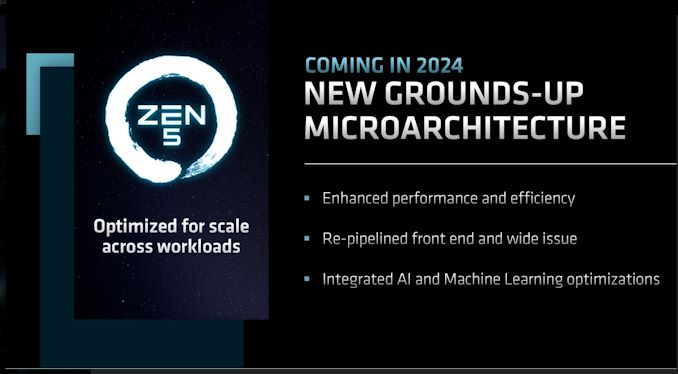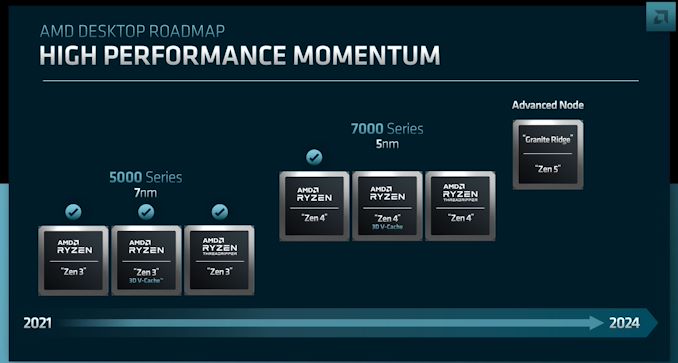AMD's Desktop CPU Roadmap: 2024 Brings Zen 5-based "Granite Ridge"
by Gavin Bonshor on June 9, 2022 6:50 PM EST- Posted in
- CPUs
- AMD
- roadmap
- TSMC
- Zen 4
- Zen 5
- V-Cache
- Ryzen 7000
- Granite Ridge
- AMD FAD 2022

As part of AMD's Financial Analyst Day 2022, it has provided us with a look at the company's desktop client CPU roadmap as we advance towards 2024. As we already know, AMD's latest 5 nm chips based on its Ryzen 7000 family are expected to launch in Fall 2022 (later this year), but the big news is that AMD has confirmed their Zen 5 architecture will be coming to client desktops sometime before the end of 2024 as AMD's "Granite Ridge" chips.
At Computex 2022, during AMD's Keynote presented by CEO Dr. Lisa Su, AMD unveiled its Zen 4 core architecture using TSMC's 5 nm process node. Despite not announcing specific SKUs during this event, AMD did unveil some expected performance metrics that we could expect to see with the release of Ryzen 7000 for desktop. This includes 1 MB per core L2 cache, which is double the L2 cache per core with Zen 3, and a 15%+ uplift in single-threaded performance.
AMD 3D V-Cache Coming to Ryzen 7000 and Beyond
One key thing to note with AMD's updated client CPU roadmap, it highlights some more on what to expect with its Zen 4 core, which is built on TSMC's 5 nm node. AMD is expecting 8-10% IPC gains over Zen 3, on top of their previously announced clockspeed gains. As a result, the company is expecting single-threaded performance to improve by at least 15%, and by even more for multi-threaded workloads.
Meanwhile AMD's 3D V-Cache packaging technology will also come to client desktop Zen 4. AMD is holding any further information close to their chest, but their current roadmap makes it clear that we should, at a minimum, expect a successor to the the Ryzen 7 5800X3D.
AMD Zen 5 For Client Desktop: Granite Ridge
The updated AMD client CPU roadmap until 2024 also gives us a time frame of when we can expect its next-generation Zen 5 cores. Built on what AMD is terming an "advanced node" (so either 4 nm or 3 nm), Zen 5 for client desktops will be Granite Ridge.
At two years out, AMD isn't offering any further details than what they've said about the overall Zen 5 architecture thus far. So while we know that Zen 5 will involve a significant reworking of AMD's CPU architecture with a focus on the front end and issue width, AMD isn't sharing anything about the Granite Ridge family or related platform in particular. So sockets, chipsets, etc are all up in the air.
But for now, AMD's full focus is on the Zen 4-based Ryzen 7000 family. Set to launch this fall, 2022 should end on a high note for the company.












35 Comments
View All Comments
alufan - Thursday, June 16, 2022 - link
I just think we are living in a fantastic period right now, Intel held us to ransom for years with high prices and frequent board changes because AMD were frankly below par, Zen has really had a very seismic effect on the whole computer chip field and the progress we have witnessed since 2017 has been exceptional, we now live in an age where I can have a 16 core 32 thread 5ghz processor in my desktop, let that sink in and then cast your minds back to 2017 and work out the cost your similarly specced PC would have been then.AMD came along guns blazing and Intel has responded, we are now seeing tit for tat increases from each side with sensible prices, we the consumer are spoiled and its great, note however Intel seems to be going back to chipset changes whereas AMD have a longer term solution, even allowing first gen boards to run 5k series processors.
mode_13h - Thursday, June 16, 2022 - link
> Intel held us to ransom for years with high prices and frequent board changesIntel CPUs did come down in price/perf, but they change boards just as frequently (new socket every 2 years) and actually the new DDR5/PCIe 5 motherboards are quite expensive.
> AMD came along guns blazing and Intel has responded
Sadly, the race has resulted in CPUs burning a lot more power. Intel was on a nice downward trend, until competition from AMD and their stalled 14 nm process forced them to build very inefficient, high-clocking processors.
Intel began the decade on a very nice trend. Gulftown CPUs burned up to 130 W, Sandybridge dropped this to 95 W, and Ivy Bridge to 77 W. Then, Intel started to reverse course, with Haswell going back up to 84 W and Skylake to 91 W. With Coffee Lake's additional cores, they had to go up to 95 W and now Alder Lake has a base power figure of 125 W.
AMD has done better, but we know Zen 4 is going to be a significant jump in base power, as they now have to respond to Golden Cove and an Intel process node that doesn't completely suck (i.e. Intel 7).
> AMD have a longer term solution, even allowing first gen boards to run 5k series processors.
There's limited value in that. You have only PCIe 3 bus and slower DDR4 speeds are probably going to choke any Zen 3 CPU with more than 8 cores.
If you space out your upgrades by at least 2 processor generations, you typically want to get a new motherboard & RAM, anyhow. It's only where people start with a CPU that's also lower-tier that upgrading within 2 generations even makes any sense.
BushLin - Thursday, June 16, 2022 - link
Your argument is logical and based on facts but for every generation there was always a more power efficient, non-flagship option if that's what you want. I think the current top end socketed Intel "35w" CPU is the i9-12900T. It's often not hard to disable turbo and not particularly technical to undervolt and/or underclock on most motherboards either... But generally I agree with the sentiment.If you care about getting value and not having what is essentially a factory overclock, AMD is probably has the better options at the moment.
And yes Apple fanboys, the Macbook Air is actually good value overall if it fits your use case and can live with the downsides of no upgrades or repairing yourself.